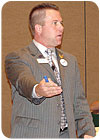
The purpose of the ridealong is to show how doing one little thing better can have an impact. Chapman used the example of water temperature. He said that water is hot at 211 degrees but boiling at 212 degrees - a small increment that has a huge impact.
"Little differences are what we are after," he said. "We want techs to do the right things."
Chapman said there are always reasons not to schedule ridealongs. "The biggest obstacles are procrastination, i.e., doing it when you say you are going to do it; confrontation, i.e., getting on the same page before starting; and rapid growth, i.e., getting better before getting bigger," he said.
Once you overcome these obstacles, Chapman noted that the first thing to do is follow a step-by-step format for the ridealong, which includes the following six steps: (1) prepare, (2) identify, (3) framing, (4) observation, (5) feed-back, and (6) wrap-up.
The preparation and identification stages should include a regular schedule that shows that all techs will be part of the ridealong program and that no one is being singled out or punished. He noted the purpose of the ridealong is spelled out in the framing stage - developing a culture of the company and sticking with a main theme of that culture.
The observation step is often difficult because an owner or manager should be there to observe only and not interfere with the tech's work, even if the tech makes a mistake or could have done something in a better way. "You have to remain in control and observe rather than interact and fix," he said.
"Even if the tech asks for help, hold off until you get to a safe environment," Chapman said.
He noted that the feedback step is the most important of all six steps. This is where the technician and observer can "communicate effectively in a safe, honest, and open way without judgment or consequences, including listen and not taking anything personal," Chapman said.
"Don't worry about the total ticket sold that day, worry about the process. It is about winning together and not punishment."
Wrapping up the ridealong is a means for maximizing the investment in the practice. Chapman believes that a company should come up with an action plan with an objective of finding two things that a tech can score better on. He said the tech should provide feedback that is kept on file.
And owners or manager have a responsibility, too. "Do what you say you are going to do, be there, and get it in writing," he said.
Publication date: 11/20/2006

Report Abusive Comment